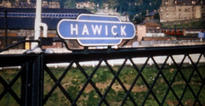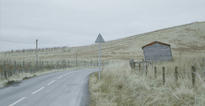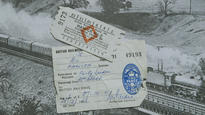IT’S QUICKER BY HEARSE · THE TALE OF THE PETITIONING HOUSEWIFE, THE PROTESTING SCHOOLBOY AND THE CAMPAIGN TRAIL STUDENT
When Madge Elliot complained about the announced closure of her local train station in Hawick, her mother told her to do something about it, and that’s just what she did. It’s Quicker By Hearse · The Tale of the Petitioning Housewife, the Protesting Schoolboy and the Campaign Trail Student tells the story of Elliot who, together with her 11-year-old son Kim, Harry Brown the piper and Edinburgh University Railway Society president Bruce McCartney, marched to Downing Street to deliver a petition of 11,768 signatures on 18 December 1968. When final closure was penciled for January 7 1969, Madge and her campaign group continued their protest by posting a coffin on the last train to leave Hawick station and travel to London. The coffin was emblazoned with the words ‘Waverley Line – born 1848 killed 1969’ and was addressed to the then Minister of Transport Richard Marsh.
Hawick was on the Waverley Route running between Carlisle and Edinburgh and was a vital connection for the Borders communities. The route was one of the first lines to be axed, closing after 120 years, as the report deemed it as being uneconomical. No other line closure left a population so far from a rail network.
This work investigates how the national changes recommended in the infamous Beeching report, titled The Reshaping of British Railways, impacted Elliot and her local community. Like Sir Walter Scott's historical novel Waverley (the railway lines namesake), Elliot’s grassroots campaign raised questions of the need for social progress that does not reject the traditions of the past.
The project is accompanied by a series of campaign placards.






- Format DIGITAL FILE(DIGITAL FILE)
- Color system PAL
- Color col.
- Year 2013
- Duration 00:19:00
- Languageinfo
Spoken: English UK
-
Artists